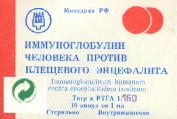The TBE Vaccine: Past, present, and
future...
In 1939, the first formalin-inactivated vaccines were developed
from mouse brain tissue, and by 1960 cell culture-derived vaccines
were created (Smorodintsev et al, 1969).
- In 1976, a partially
purified formalin-inactivated vaccine (Austrian virus grown in chick
embryo cells) became commercially available in Europe. This vaccine
gave satisfactory conversion rates but caused a significant rate of
adverse effects (Fields, 1995)
- The common side effects
included headache, malaise, and fever.
- Vaccine purification,
by continuous flow zonal ultracentrifugation (Heinz et al, 1981),
reduced the frequency of side effects. However, fever, local
redness, swelling and pain still occur in <10%.
- The
purified injectable vaccine is licensed in Europe (FSME-Immun,
Immuno AG, Vienna). It contains Al(OH3) as an adjuvant and has an
efficacy of about 97-98% (Stevenson et al, 1991).

- In Canada, vaccine can
only be accessed by asking your physician who must make a request to
the HPB. Vaccine is supplied to the HPB by Imuuno Canada.
-Research into alternative, more effective TBEV vaccines, is
ongoing. For example, live vaccines that yield lifelong immunity,
made from non-virulent strains are being investigated (Gresikova et
al, 1986; Smorodintsev et al, 1969); NS1-based vaccines, that do not
use virion surface proteins to avoid the possibility of inducing
antibody-dependent enhancement (ADE) of infection (Jacobs et al,
1994; Jacobs, 1993); and the addition of HGH to the aluminum
hydroxide matrix, which may help to stimulate the initial clonal
expansion of virus-specific T cells thereby enhancing the immune
response against the virus (Stevenson et al, 1991).
Vaccine Dosing Schedule:
- Three doses of the inactivated vaccine are required.
- The
2nd dose given 1-3 mos. after the 1st dose, and the 3rd dose is
given after 9-12 mos.
- After vaccination with 1,2, and 3 doses,
seroconversion rate was found to be >70%, 95%, and >99%, as
measured within a month after vaccination. Within twelve months 40%,
53%, and 79% were still seropositive (Gustafson et al, 1992).
-
The vaccine provides adequate protection for approximately three
years.
Who should be Vaccinated?
- Persons living in endemic areas.
- Persons working under
high-risk conditions (foresters, farmers, butchers, military
personnel, laboratory workers).
- Travelers engaged in high-risk
activities (field work, camping, hiking).
- Livestock,
milk-producing animals (cows & goats).
Prevention of Tick Bites & Virus
Exposure:
- Avoid wooded areas.
- Minimize tick
attachment by:
- Wearing permethrin (insecticide) impregnated clothing
- Application of DEET (N,N-diethyl-m-toluamide; insect
repellent).
- Wear light-coloured clothing (facilitates detection).
- Secure cuffs with tape or tuck them into socks.
- Remove ticks, using tweezers or gloved hands, as soon as
possible, since it takes at least an hour for an infected tick,
nymph, or larva to inject the virus while feeding.
- Elimination
of ticks using acaricides may be used in highly infested areas
(pesticide use is not recommended due to environmental concerns)
- Avoid consumption of unpasturized dairy products in endemic
areas.
Treatment
- Passive immunization with TBE-specific Ab can be used for
post-exposure prophylaxis (Wenrong et al, 1994).
- If given
within 4 days of bite, it is estimated to be effective in 60-70% of
cases.
